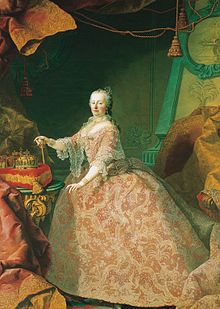- Symphony No. 48 (Haydn)
-
The Symphony No. 48 in C major, Hoboken I/48, is a symphony by Joseph Haydn written in 1768 or 1769. The work has the nickname Maria Theresia as it was long thought to have been composed for a visit by the Holy Roman Empress, Maria Theresa of Austria in 1773. An earlier copy dated 1769 was later found, but the nickname has stuck.[1] The symphony composed for the empress's visit was most likely No. 50.[1][2]
H. C. Robbins Landon has described this symphony as a "great and indeed germinal work." It was one of the very few Haydn symphonies of this period to survive throughout the nineteenth century in various editions.[3]
Contents
Instrumentation
The symphony is scored for two oboes, bassoon, two horns (first, third and last movement in C alto, second movement in F), and strings. Parts for two trumpets and timpani were added later but scholars are not sure whether or not these really are by Haydn.[4] Some copies of the Eulenburg edition include two different timpani parts on the same staff, the more doubtful version differentiated by stems down and written in a facsimile of handwriting.
Movements
- Allegro, 4/4
- Adagio in F major, 6/8
- Menuet: Allegretto & trio, 3/4
- Finale: Allegro, 2/2
The first movement "contains a development section more complex than the minor-keyed symphonies of the same period, but not as complex as the C major Fürnberg-Morzin symphonies," and the finale has a "secondary development" in the recapitulation that compensates for the brevity of the actual development.[5]
Haydn later quoted the opening of the first movement in his "Laudon" Symphony (no. 69).
See also
References
- ^ a b Brown, A. Peter, The Symphonic Repertoire (Volume 2). Indiana University Press (ISBN 025333487X), pp. 114-115(2002).
- ^ Antony Hodgson, The Music of Joseph Haydn: The Symphonies. London: The Tantivy Press (1976): 77.
- ^ HC Robbins Landon, Haydn: Chronicle and Works, 5 vols, (Bloomington and London: Indiana University Press, 1976-) v. 2, Haydn at Eszterhaza, 1766-1790
- ^ H. C. Robbins Landon, The Symphonies of Joseph Haydn New York: Macmillan (1956): 688. "Originally for 2 ob., 2 cor. in C alto and F, str. [fag.] Parts for 2 clarini and timp. added later; It is not certain that the crude timpani part in the EH archives is really Haydn's. ... The modern trumpet and timp. parts as pub. in the B & H. orchestral parts and the Eulenburg score (etc.) are patent forgeries."
- ^ William E. Grim, Haydn's Sturm und Drang Symphonies: Form and Meaning. Lewiston: The Edwin Mellen Press (1990): 50
External links
- Symphony No. 48: Free scores at the International Music Score Library Project.

This article about a symphony is a stub. You can help Wikipedia by expanding it.

